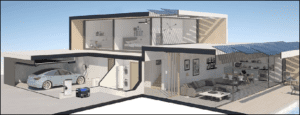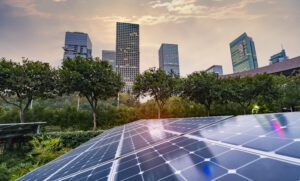After the breakout of a global pandemic in 2020, people have realized how little we can control when it comes to combating the raging impacts of nature.
This has prompted people to think more about significant issues like environmental degradation and sustainable development. In order to accelerate the growth and development of a country, researchers and expert professionals are coming up with a range of high-performance solutions that can deliver optimum results while saving a significant amount of energy.
This article will bring examine the need, benefits, and advantages of building an energy-efficient home. The introduction of technological advancements and digitization has brought a significant change in the way buildings operate.
A few decades ago, building structures were constructed in a very simple and concrete manner meaning, they didn’t have a mind of their own. Hence, in order to ensure that every installed system is working effectively, it required more resources, such as operators, technicians, and administrators. However, the introduction of smart homes, smart buildings, and smart offices has transformed how buildings operate and function.

What is an energy-efficient home?
An energy efficient home is designed to optimize energy use, minimize wastage, and reduce its overall environmental footprint. It integrates advanced construction techniques, materials, and systems to ensure that energy consumption is as low as possible while maintaining comfort and functionality.
Building an energy-efficient home often involves a holistic approach. It considers factors such as insulation, window placement, and the use of energy-efficient appliances. Proper insulation reduces the need for heating and cooling, and strategic window placement can harness natural sunlight for warmth and illumination.
The incorporation of renewable energy sources, like solar panels, further boosts the sustainability of such homes. Additionally, an energy-efficient home might employ technologies like smart thermostats and LED lighting to save energy. Building such a home not only results in significant savings on utility bills but also contributes to a more sustainable future by reducing greenhouse gas emissions and reliance on non-renewable resources.
An insight into building an energy efficient home
Before understanding how an energy-efficient home is built, we first need to understand the definition and advantages of building automation[1]. The primary purpose of BAS or a building automation system is to ensure that the building climate is maintained within a specific range.
These systems are exclusively designed to reduce the maintenance cost and energy consumption levels of a building in contrast with a conventional or a non-controlled building. Below we have mentioned some of the many components of an energy-efficient home:
Internet of Things (IoT)
IoT refers to intricately installed software, sensors, processability, and many other technologies that efficiently exchange and connect data with other devices over the internet. Some of the many IoT devices that play an integral role in building an energy-efficient home are motion detectors, light sensors, cameras, and more.
Smartphone applications
If one invests in a top-notch home automation system, smartphone apps can play an imperative role in building an energy-efficient home. Today, since everyone carries a smartphone, it can perform functions like regulating actuators, different onboarding devices, monitoring sensors, formulating rules, and more.
Seamless connectivity
Lastly, one needs a platform where all the smart devices can sync and connect to the internet. Thus, Wi-Fi and cellular-based networking options are the most widely deployed connectivity solutions.
Applications that are connected with cellular data are a popular choice as they can deliver results over long periods of time but might turn out to be an expensive purchase for some people. Conversely, Wi-Fi is a local area network that offers adequate coverage across domestic and commercial buildings.
Benefits of building an energy efficient home
Building an energy-efficient home can prove to be advantageous from two perspectives. First, it allows the user to smartly integrate DES into the operations and design of the building in accordance with their requirements.
Therefore, since smart homes and buildings have room for flexibility and customization, it uses best-in-class devices to secure the overall energy supply and increases energy efficiency while reducing carbon and greenhouse gas emissions.
Next, since several devices, technologies, and tools are employed to save energy, it also cuts down on the overall electricity bill of the home or organization. This amount of money can then be used in enhancing other features of the house or office like architecture, infrastructure, safety systems, etc. Now, let us have a look at a range of benefits one can enjoy by building an energy-efficient home:
1. Enhanced comfort
Building an energy-efficient or smart home allows the occupants to adjust several factors like temperature, air movement and ventilation according to their convenience. In other words, they can preprogram their requirements, and the installed devices will maintain that accordingly.
2. Profitable resale
Since smart homes offer better productivity with enhanced comfort levels, they can be sold at higher rates in comparison with a conventional home. In addition, as people today are much more aware of technological advancements, they will readily invest in a smart and energy-efficient home.
3. Reliable construction
To build an energy-efficient house, one needs a professionally trained and skilled set of architectures, technicians, and operators. Unlike a traditional house or building, a smart house needs to be intricately designed by using quality tools and resources so that the output levels are not compromised.
Principles of building an energy-efficient home
Building an energy-efficient home is more than just a sustainable endeavor; it’s about creating a space that is comfortable, sustainable, and cost-effective. Incorporating energy-efficient principles into the home design not only reduces the carbon footprint. It also brings down energy bills and ensures a healthier living environment. Here are some core principles to consider:
- Orientation and layout: The orientation of your home can have a significant impact on energy consumption. Ideally, the longest sides of the house should face north and south to capitalize on natural sunlight. This reduces the need for artificial lighting and provides passive solar heating in colder months.
- Insulation: Proper insulation is crucial for maintaining a comfortable indoor temperature. Insulate walls, roofs, and floors to prevent heat loss in the winter and heat gain in the summer. Using high-quality insulation materials ensures maximum energy conservation.
- Window selection: Double-glazed or triple-glazed windows can significantly reduce heat transfer. Positioning windows to facilitate cross-ventilation helps in cooling the house naturally, reducing the need for air conditioning.
- Energy-efficient appliances: Equip your home with energy-star-rated appliances. These appliances consume less energy compared to standard models, helping to reduce electricity bills.
- Water efficiency: Use water-saving fixtures like low-flow toilets and aerated faucets. Additionally, consider rainwater harvesting systems and greywater recycling for landscaping and non-potable purposes.
- Green building materials: Opt for sustainable, non-toxic, and locally sourced materials. They have lower environmental impacts and often provide better indoor air quality.
- Solar integration: Incorporate solar panels to harness solar energy for electricity. Also, use solar water heaters to reduce the consumption of grid electricity or gas.
- Efficient HVAC systems: Modern heating, ventilation, and air conditioning systems consume less energy while providing optimal comfort. Regular maintenance ensures they operate efficiently.
- Home automation and monitoring: Smart thermostats and home energy monitoring systems can provide real-time data on energy consumption. This empowers homeowners to make adjustments that can lead to significant energy savings.
- Landscaping: Plant deciduous trees on the southern and western sides of the home. These trees provide shade in summer, reducing cooling needs, and let in sunlight during winter.
Building an energy efficient home requires a holistic approach, considering everything from orientation to appliance selection. Incorporating these principles not only ensures energy conservation but also provides long-term financial savings and a healthier living space.
Collaborate with Schneider Electric to build an energy-efficient home
Our experts at Schneider Electric work diligently to meet all your needs and requirements in an efficient manner. Apart from providing a range of electrical products, services, and solutions, we take special measures to ensure that the gap between sustainability and progress is filled in an effective manner.
Our carbon pledge stands as a testament to our accelerated journey towards sustainability. By the year 2050, we aim to achieve net-zero carbon dioxide emissions across our entire value chain. Explore our Climate Commitments page to learn more.



